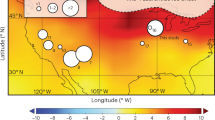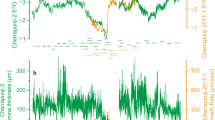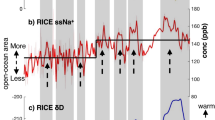Abstract
No glacial inception is projected to occur at the current atmospheric CO2 concentrations of 390 ppmv (ref. 1). Indeed, model experiments suggest that in the current orbital configuration—which is characterized by a weak minimum in summer insolation—glacial inception would require CO2 concentrations below preindustrial levels of 280 ppmv (refs 2, 3, 4). However, the precise CO2 threshold4,5,6 as well as the timing of the hypothetical next glaciation7 remain unclear. Past interglacials can be used to draw analogies with the present, provided their duration is known. Here we propose that the minimum age of a glacial inception is constrained by the onset of bipolar-seesaw climate variability, which requires ice-sheets large enough to produce iceberg discharges that disrupt the ocean circulation. We identify the bipolar seesaw in ice-core and North Atlantic marine records by the appearance of a distinct phasing of interhemispheric climate and hydrographic changes and ice-rafted debris. The glacial inception during Marine Isotope sub-Stage 19c, a close analogue for the present interglacial, occurred near the summer insolation minimum, suggesting that the interglacial was not prolonged by subdued radiative forcing7. Assuming that ice growth mainly responds to insolation and CO2 forcing, this analogy suggests that the end of the current interglacial would occur within the next 1500 years, if atmospheric CO2 concentrations did not exceed 240±5 ppmv.
This is a preview of subscription content, access via your institution
Access options
Subscribe to this journal
Receive 12 print issues and online access
$259.00 per year
only $21.58 per issue
Buy this article
- Purchase on Springer Link
- Instant access to full article PDF
Prices may be subject to local taxes which are calculated during checkout




Similar content being viewed by others
Change history
10 January 2012
The PDF of this Letter originally appeared with the incorrect 'published online' date of 8 January 2012; the actual date it went live was 9 January 2012. The date is now correct on all versions of the Letter.
References
Archer, D. & Ganopolski, A. A movable trigger: Fossil fuel CO2 and the onset of the next glaciation. Geochem. Geophys. Geosyst. 6, Q05003 (2005).
Loutre, M. F. & Berger, A. Future climatic changes: are we entering an exceptionally long interglacial? Climatic Change 46, 61–90 (2000).
Vettoretti, G. & Peltier, W. R. Sensitivity of glacial inception to orbital and greenhouse gas climate forcing. Quat. Sci. Rev. 23, 499–519 (2004).
Cochelin, A-S., Mysak, L. A. & Wang, Z. Simulation of long-term future climate changes with the green McGill paleoclimate model: The next glacial inception. Climatic Change 79, 381–401 (2006).
Calov, R., Ganopolski, A., Kubatzki, C. & Claussen, M. Mechanisms and time scales of glacial inception simulated with an Earth system model of intermediate complexity. Clim. Past 5, 245–258 (2009).
Kutzbach, J. E., Ruddiman, W. R., Vavrus, S. J. & Philippon, G. Climate model simulation of anthropogenic influence on greenhouse-induced climate change (early agriculture to modern): The role of ocean feedbacks. Climatic Change 99, 351–381 (2010).
Vettoretti, G. & Peltier, W. R. The impact of insolation, greenhouse gas forcing and ocean circulation changes on glacial inception. Holocene 21, 803–817 (2011).
Kukla, G. J., Matthews, R. K. & Mitchell, J. M. The end of the present interglacial. Quat. Res. 2, 261–269 (1972).
Masson-Delmotte, V. et al. Past temperature reconstructions from deep ice-cores: Relevance for future climate change. Clim. Past 2, 145–165 (2006).
Ruddiman, W. F. The early anthropogenic hypothesis: Challenges and responses. Rev. Geophys. 45, RG4001 (2007).
Ruddiman, W. F., Kutzbach, J. E. & Vavrus, S. J. Can natural or anthropogenic explanations of late-Holocene CO2 and CH4 increases be falsified? Holocene 21, 865–879 (2011).
Lüthi, D. et al. High-resolution carbon dioxide concentration record 650,000–800,000 years before present. Nature 453, 379–382 (2008).
Loulergue, L. et al. Orbital and millennial-scale features of atmospheric CH4 over the past 800,000 years. Nature 453, 383–386 (2008).
Tzedakis, P. C. et al. Interglacial diversity. Nature Geosci. 2, 751–755 (2009).
Rohling, E. J. et al. Comparison between Holocene and Marine Isotope Stage-11 sea-level histories. Earth Planet. Sci. Lett. 291, 97–105 (2010).
EPICA community members, Eight glacial cycles from an Antarctic ice core. Nature 429, 623–628 (2004).
Tzedakis, P. C. The MIS 11—MIS 1 analogy, southern European vegetation, atmospheric methane and the early anthropogenic hypothesis. Clim. Past 6, 131–144 (2010).
Jouzel, J. et al. Orbital and millennial antarctic climate variability over the past 800,000 years. Science 317, 793–796 (2007).
Stocker, T. F. & Johnsen, S. J. A minimum thermodynamic model for the bipolar seesaw. Paleoceanography 18, PA1087 (2003).
Shackleton, N. J., Hall, M. A. & Vincent, E. Phase relationships between millennial-scale events 64,000–24,000 years ago. Paleoceanography 15, 565–569 (2000).
Margari, V. et al. The nature of millennial-scale climate variability during the past two glacial periods. Nature Geosci. 3, 127–133 (2010).
Hodell, D. A., Evans, H. F., Channell, J. E. T. & Curtis, J. H. Phase relationships of North Atlantic ice rafted debris and surface sediment proxies during the last glacial period. Quat. Sci. Rev. 29, 3875–3886 (2010).
Skinner, L. C., Elderfield, H. & Hall, M. in Past and Future Changes of the Ocean’s Meridional Overturning Circulation: Mechanisms and Impacts (eds Schmittner, A., Chiang, J. & Hemming, S. R.) 197–208 (AGU Monograph, 2007).
Thompson, W. G. & Goldstein, S. L. A radiometric calibration of the SPECMAP timescale. Quat. Sci. Rev. 25, 3207–3215 (2006).
Channell, J. E. T. & Kleiven, H. F. Geomagnetic palaeointensitites and astrochronological ages for the Matuyama–Brunhes boundary and the boundaries of the Jaramillo Subchron: Palaeomagnetic and oxygen isotope records from ODP Site 983. Phil. Trans. R. Soc. Lond. Ser. A 358, 1027–1047 (2000).
Kleiven, H. F., Hall, I. R., McCave, I. N., Knorr, G. & Jansen, E. Coupled deep-water flow and climate variability in the middle Pleistocene North Atlantic. Geology 39, 343–346 (2011).
Channell, J. E. T., Hodell, D. A., Singer, B. S. & Xuan, C. Reconciling astrochronological and 40Ar/39Ar ages for the Matuyama–Brunhes boundary and late Matuyama Chron. Geochem. Geophys. Geosyst. 11, Q0AA12 (2010).
Lisiecki, L. E. & Raymo, M. E. A Pliocene–Pleistocene stack of 57 globally distributed benthic δ18O records. Paleoceanography 20, PA1003 (2005).
Laskar, J. et al. A long term numerical solution for the insolation quantities of the Earth. Astron. Astrophys. 428, 261–285 (2004).
Huybers, P. Early Pleistocene glacial cycles and the integrated summer insolation forcing. Science 313, 508–511 (2006).
Acknowledgements
We are grateful to members of the Past Interglacials (PIGS) working group of the Past Global Changes (PAGES) project, especially B. Thompson, A. Landais and J. McManus, for discussions. We thank R. Preece and M. Maslin for comments on the manuscript and D. Oppo for providing ODP980 data. H.F.K. acknowledges support from the Research Council of Norway, AMOCINT project; P.C.T. acknowledges support from the UK Natural Environment Research Council. This is a contribution to the PAGES PIGS project.
Author information
Authors and Affiliations
Contributions
All authors contributed to the ideas developed in the paper. P.C.T. wrote the paper, with contributions from the other authors.
Corresponding author
Ethics declarations
Competing interests
The authors declare no competing financial interests.
Supplementary information
Supplementary Information
Supplementary Information (PDF 528 kb)
Rights and permissions
About this article
Cite this article
Tzedakis, P., Channell, J., Hodell, D. et al. Determining the natural length of the current interglacial. Nature Geosci 5, 138–141 (2012). https://doi.org/10.1038/ngeo1358
Received:
Accepted:
Published:
Issue Date:
DOI: https://doi.org/10.1038/ngeo1358
This article is cited by
-
Radiocarbon evidence for the stability of polar ocean overturning during the Holocene
Nature Geoscience (2023)
-
Revisiting the Holocene global temperature conundrum
Nature (2023)
-
Preface for the article collection “Stratigraphy and paleoclimatic/paleoenvironmental evolution across the Early–Middle Pleistocene transition in the Chiba composite section, Japan, and other reference sections in East Asia”
Progress in Earth and Planetary Science (2022)
-
Wood Vault: remove atmospheric CO2 with trees, store wood for carbon sequestration for now and as biomass, bioenergy and carbon reserve for the future
Carbon Balance and Management (2022)
-
Millennial-scale oscillations in the Kuroshio–Oyashio boundary during MIS 19 based on the radiolarian record from the Chiba composite section, central Japan
Progress in Earth and Planetary Science (2022)



